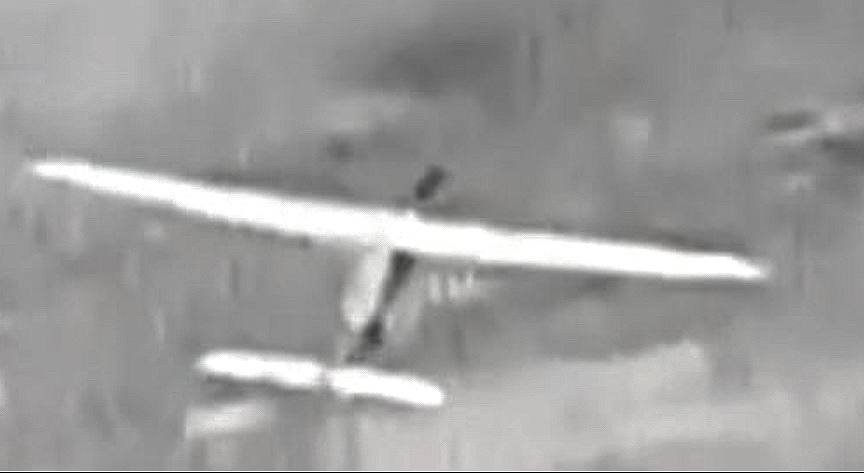Video of a Ukrainian FPV taking down a Russian ZALA 421-16 UAV. Sternenko says one of his FPVs took down an Orlan UAV as well but these cases are rare.
t.me/ssternenko/292…
t.me/yigal_levin/67…
t.me/ssternenko/292…
t.me/yigal_levin/67…
Video of a Russian Orlan UAV brought down by a UAV by Ukrainian SBU Alpha’s M2 unit. 3/
t.me/ssternenko/293…
t.me/ssternenko/293…
Reportedly the first video of an FPV strike on a Russian Zala 421-16 UAV by Ukraine’s 1st Tank Brigade. 7/
t.me/PEGAS_1OTBr/99
t.me/PEGAS_1OTBr/99
A Russian channel warns of the increased threat posed by Ukrainian FPVs to ISR UAVs at altitudes of 1,200-2,500 meters and recommends avoiding establishing patterns. 9/
t.me/xronikabpla/72…


t.me/xronikabpla/72…


Presumably, related. 17/
https://twitter.com/RALee85/status/1809341919668953371
Videos posted by a Russian channel showing Ukrainian FPVs attempting to ram Russian ISR UAVs. Russian operators intercepted the video signal. 18/
t.me/UAVDEV/6773
t.me/serhii_flash/3…
t.me/UAVDEV/6773
t.me/serhii_flash/3…
Video of FPVs from Ukraine’s 38th Marine Brigade targeting Russian Supercam, Orlan, and Zala UAVs. 26/
t.me/savelifeua/2914
t.me/savelifeua/2914
Video of an FPV from Ukraine's 47th Mechanized Brigade targeting a Russian Zala UAV. 28/
t.me/ButusovPlus/12…
t.me/ButusovPlus/12…
Video from Ukraine’s 110th Mechanized Brigade showing FPV strikes on Russian Zala UAVs. 30/
t.me/BUAR110ombr/375
t.me/BUAR110ombr/375
Video of an FPV from Ukraine's 501st Marine Battalion targeting a Russian Zala UAV. 31/
t.me/GRIFON501/480
t.me/GRIFON501/480
Video of a Ukrainian FPV targeting a Russian Orlan UAV (the footage was intercepted by the Russians), and a Ukrainian UAV attempting to down a Russian ISR UAV but narrowly missing. 35/
t.me/infomil_live/9…
t.me/infomil_live/9…
t.me/infomil_live/9…
t.me/infomil_live/9…
Video from Ukraine's 117th Mechanized Brigade of an FPV targeting a Russian Supercam UAV. 39/
facebook.com/117ombr/videos…
facebook.com/117ombr/videos…
Screenshots of Ukrainian FPVs, including with thermal cameras, targeting Russian Zala, Supercam, and Orlan UAVs and Lancet loitering munition. 41/
t.me/BaluHub777/143…
t.me/BaluHub777/143…
t.me/BaluHub777/144…
t.me/BaluHub777/144…
t.me/BaluHub777/144…
t.me/BaluHub777/144…
t.me/BaluHub777/144…



t.me/BaluHub777/143…
t.me/BaluHub777/143…
t.me/BaluHub777/144…
t.me/BaluHub777/144…
t.me/BaluHub777/144…
t.me/BaluHub777/144…
t.me/BaluHub777/144…




Videos of Ukrainian FPV strikes on a Russian Lancet loitering munition, Supercam, and Zala UAV. 42/
t.me/ssternenko/332…
t.me/savelifeua/3024
t.me/nebo_peremogy/…
t.me/ssternenko/332…
t.me/savelifeua/3024
t.me/nebo_peremogy/…
Video from Ukraine's 93rd Mechanized Brigade's Signum unit showing FPV strikes on 48 ISR UAVs and a Lancet loitering munition. 44/
t.me/umftteam/386
t.me/umftteam/386
More FPV strikes on Russian ISR UAVs. 46/
t.me/savelifeua/3030
t.me/savelifeua/3033
t.me/ssternenko/333…
t.me/DeepStateUA/20…


t.me/savelifeua/3030
t.me/savelifeua/3033
t.me/ssternenko/333…
t.me/DeepStateUA/20…


Photos of Ukrainian fixed-wing UAV interceptors designed to target Russian ISR UAVs. They have a reported range of 50-60km and fly at an altitude of 4km. 47/
mil.in.ua/en/news/ukrain…


mil.in.ua/en/news/ukrain…


More FPV strikes on Russian ISR UAVs. The first video occurred at an altitude of more than 3km. 50/
t.me/army_3otbr/644
t.me/ssternenko/334…
t.me/army_3otbr/644
t.me/ssternenko/334…
More Ukrainian FPV strikes on Russian ISR UAVs, including a Merlin-VR and a Zala targeted by an FPV with a thermal camera. 52/
t.me/OGSHB_109/756
t.me/DeepStateUA/20…
t.me/savelifeua/3034
t.me/savelifeua/3040
t.me/savelifeua/3044
t.me/savelifeua/3042
t.me/OGSHB_109/756
t.me/DeepStateUA/20…
t.me/savelifeua/3034
t.me/savelifeua/3040
t.me/savelifeua/3044
t.me/savelifeua/3042
• • •
Missing some Tweet in this thread? You can try to
force a refresh























